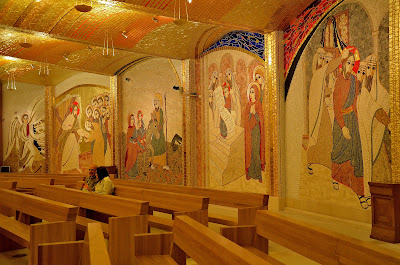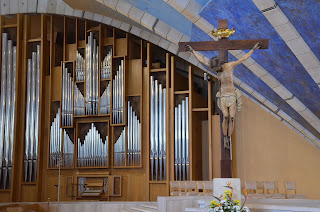THE SANCTUARY OF ST. PIO
SAN GIOVANNI ROTONDO
The Church, or the Sanctuary of St. Pio, is with its 6000 square meters (and a capacity of 7000 persons), one of the biggest churches in Italy.
Commissioned by the Order of Friars Minor Capuchin of Province of Foggia, almost entirely financed by the pilgrims, was designed by Renzo Piano, architect of world fame, and made in about 10 years of work.
It is located near the Church of Santa Maria delle Grazie.
To get to church you go through a access avenue in which were placed 24 olive trees, and at the same side of the avenue have been placed 12 trapezoid tanks which are the symbol of the Jordan and that carries water to the octagonal font. On the opposite side sculptures of Mario Rossello representing eagles, some bells and a 40 m high stone cross, sign of labor and of victory.
The great churchyard in stone of Apricena can accommodate about 30,000 people and is named after Pope John Paul II.
The style of the Church is not traditional, which has given rise to much criticism: it seems more a style appropriate to a stadium that a religious building.
I think so, to be honest.
It is shaped like a "Nautilus", the cover is pre-oxidized copper colored "green copper", precisely, and is lower to the vestry, and rises gradually up to the highest point where the Church is united with the churchyard.
It is supported by wooden tangential and radial beams , and is further supported by the arches attached with internal steel stirrups.


In the Upper Church liturgical hall has three naves. Arches performing radial from the center, are arranged in two rows, one internal and one external, which start from the altar and the presbytery with their games allow natural light to filter by creating shadows.
The rear row meets in a single central pillar in the direction of the altar (which is thus the centrality of Christ, the cornerstone of the Church).
The altar is placed on some steps upward.
The altar is placed on some steps upward.
A majestic pipe organ is placed laterally to the area of liturgical celebration. It was built in 2005 and the facade was also designed by Renzo Piano.
The height of the arches from the churchyard degrades towards the Eucharist Chapel , which is adjacent to the liturgical Chamber and which leads inside the Tabernacle.
The entrance door, by Mimmo Palladino, is made of bronze and has two panels on the representations of the Good Shepherd and of Abraham.

The Lower Church contains the crypt where the body of St. Pio has been shifted on 19/04/2010.
One can not fail to be amazed ... not for anything someone has called this place the "Sistine Chapel of the Gargano."
One can not fail to be amazed ... not for anything someone has called this place the "Sistine Chapel of the Gargano."
With its 2500 square meters and with the millions of colored tiles that make up a cycle of mosaics designed by Father Marko Rupnik (Director of the Centro Aletti at the Pontifical Oriental Institute), is nothing short of monumental.
Access is through a ramp of 80 meters, in which there is described the "path of the new man" through the mosaics on scenes from the life of St. Francesco and St. Pio.

Entering the Crypt you are surrounded by breathtaking scenery. The golden vault, in a circular room, were made with 10 kg of gold, obtained by melting ex-votos and processed into thin strips.
The cycle of mosaics now concerns the Christ and his life.
The cycle of mosaics now concerns the Christ and his life.

The urn of Padre Pio, a shrine of silver and gold of about 150 kg and covered in precious gems, is situated in the central pylon, in a cleft, the side wound of Christ.
And on a side on the pylon, stands in fact, Jesus in glory, with an angel that honors him. He is holding an open book on which it is written:
And on a side on the pylon, stands in fact, Jesus in glory, with an angel that honors him. He is holding an open book on which it is written:
"I AM THE LIFE."
"These mosaics are a lecture on theology," said Benedict XVI during his visit.
Someone said: "It 'a piece of sky", "Anticipation of Heaven."
I do not know. The question remains whether Padre Pio, from above, with its simplicity, has not appreciated. Just one question, anyhow.
Someone said: "It 'a piece of sky", "Anticipation of Heaven."
I do not know. The question remains whether Padre Pio, from above, with its simplicity, has not appreciated. Just one question, anyhow.








Nessun commento:
Posta un commento